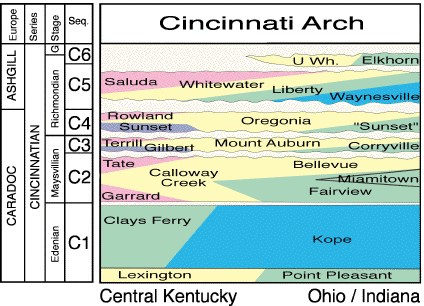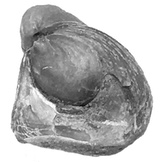Lithostratigraphic Overview

A bewildering profusion of lithostratigraphic names have been applied to the type Cincinnatian Series, largely because of the complex intertonguing of the lithofacies and their similarity to one another. Sequence stratigraphy offers a way to select a consistent set of lithostratigraphic names, which are shown to the left. Peritidal facies are shown in pink, shallow subtidal facies in yellow, deep subtidal in green, offshore in blue, and lagoonal in purple.
Early workers on the Cincinnatian divided the series up into groups, formations, and members, all based partly on lithology and partly on fossils. These divisions were fairly effective in the regions in which they were first established, but were not easily applied in areas farther away, such as central Kentucky. With the advent of a modern stratigraphic code, it became clear that having units defined on multiple criteria (rock type and fossils) was not desirable, and that a clear distinction between lithostratigraphic (rock-based) and biostratigraphic (fossil-based) units must be made. Beginning in the 1960's and continuing until the 1980's, the U.S. Geological Survey, as well as the state geological surveys of Kentucky, Indiana, and Ohio, began to establish new systems of lithostratigraphic nomenclature for the Upper Ordovician rocks of the Cincinnati Arch.
These new systems did not do away with the problem of nomenclature; in some ways, they made it worse, despite being clearer in their basis for naming mappable rock units. One problem was that each state largely adopted its own nomenclature, resulting in a state-line stratigraphy that hid stratigraphic relationships. Another was that these systems divided the Cincinnatian at a coarser scale than the earlier bio-lithostratigraphic system had, resulting in a loss of stratigraphic resolution. Third, these new systems of nomenclature did not have a common basis for what constituted a formation, that is, what degree of lithologic variation could be encompassed in a formation. Because many of the lithologic transitions in the type Cincinnatian are gradational, a profusion of lithostratigraphic names emerged, all attempting to solve the problems of mappability.
One voice of fresh air into this situation was that of Rick Tobin, a University of Cincinnati Ph.D. student, who realized after a facies analysis of the Cincinnatian Series, that many of the early combined bio-lithostratigraphic units could be redefined at a consistent scale of lithologic variation as purely lithostratigraphic units. In this way, much of the early, established nomenclature could be preserved, and large-scale units that lumped lithologic variation could be done away with. Subsequent work in central Kentucky revealed that these same principles could be extended to central Kentucky. As a result, a sequence stratigraphic framework could be used to improve the system of lithostratigraphic nomenclature, maintain high stratigraphic resolution, improve an understanding of facies relationships, and see through the problems of state-line stratigraphy.

